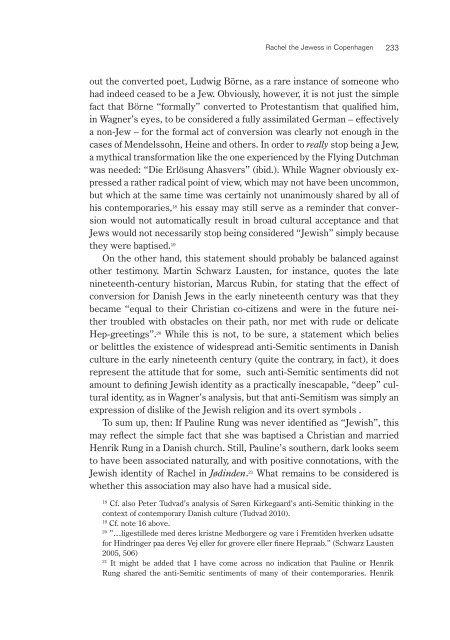Opera on the Move in the Nordic Countries during the Long 19th ...
Opera on the Move in the Nordic Countries during the Long 19th ...
Opera on the Move in the Nordic Countries during the Long 19th ...
Create successful ePaper yourself
Turn your PDF publications into a flip-book with our unique Google optimized e-Paper software.
Rachel <strong>the</strong> Jewess <strong>in</strong> Copenhagen<br />
233<br />
out <strong>the</strong> c<strong>on</strong>verted poet, Ludwig Börne, as a rare <strong>in</strong>stance of some<strong>on</strong>e who<br />
had <strong>in</strong>deed ceased to be a Jew. Obviously, however, it is not just <strong>the</strong> simple<br />
fact that Börne “formally” c<strong>on</strong>verted to Protestantism that qualified him,<br />
<strong>in</strong> Wagner’s eyes, to be c<strong>on</strong>sidered a fully assimilated German – effectively<br />
a n<strong>on</strong>-Jew – for <strong>the</strong> formal act of c<strong>on</strong>versi<strong>on</strong> was clearly not enough <strong>in</strong> <strong>the</strong><br />
cases of Mendelssohn, He<strong>in</strong>e and o<strong>the</strong>rs. In order to really stop be<strong>in</strong>g a Jew,<br />
a mythical transformati<strong>on</strong> like <strong>the</strong> <strong>on</strong>e experienced by <strong>the</strong> Fly<strong>in</strong>g Dutchman<br />
was needed: “Die Erlösung Ahasvers” (ibid.). While Wagner obviously expressed<br />
a ra<strong>the</strong>r radical po<strong>in</strong>t of view, which may not have been uncomm<strong>on</strong>,<br />
but which at <strong>the</strong> same time was certa<strong>in</strong>ly not unanimously shared by all of<br />
his c<strong>on</strong>temporaries, 18 his essay may still serve as a rem<strong>in</strong>der that c<strong>on</strong>versi<strong>on</strong><br />
would not automatically result <strong>in</strong> broad cultural acceptance and that<br />
Jews would not necessarily stop be<strong>in</strong>g c<strong>on</strong>sidered “Jewish” simply because<br />
<strong>the</strong>y were baptised. 19<br />
On <strong>the</strong> o<strong>the</strong>r hand, this statement should probably be balanced aga<strong>in</strong>st<br />
o<strong>the</strong>r testim<strong>on</strong>y. Mart<strong>in</strong> Schwarz Lausten, for <strong>in</strong>stance, quotes <strong>the</strong> late<br />
n<strong>in</strong>eteenth-century historian, Marcus Rub<strong>in</strong>, for stat<strong>in</strong>g that <strong>the</strong> effect of<br />
c<strong>on</strong>versi<strong>on</strong> for Danish Jews <strong>in</strong> <strong>the</strong> early n<strong>in</strong>eteenth century was that <strong>the</strong>y<br />
became “equal to <strong>the</strong>ir Christian co-citizens and were <strong>in</strong> <strong>the</strong> future nei<strong>the</strong>r<br />
troubled with obstacles <strong>on</strong> <strong>the</strong>ir path, nor met with rude or delicate<br />
Hep-greet<strong>in</strong>gs”. 20 While this is not, to be sure, a statement which belies<br />
or belittles <strong>the</strong> existence of widespread anti-Semitic sentiments <strong>in</strong> Danish<br />
culture <strong>in</strong> <strong>the</strong> early n<strong>in</strong>eteenth century (quite <strong>the</strong> c<strong>on</strong>trary, <strong>in</strong> fact), it does<br />
represent <strong>the</strong> attitude that for some, such anti-Semitic sentiments did not<br />
amount to def<strong>in</strong><strong>in</strong>g Jewish identity as a practically <strong>in</strong>escapable, “deep” cultural<br />
identity, as <strong>in</strong> Wagner’s analysis, but that anti-Semitism was simply an<br />
expressi<strong>on</strong> of dislike of <strong>the</strong> Jewish religi<strong>on</strong> and its overt symbols .<br />
To sum up, <strong>the</strong>n: If Paul<strong>in</strong>e Rung was never identified as “Jewish”, this<br />
may reflect <strong>the</strong> simple fact that she was baptised a Christian and married<br />
Henrik Rung <strong>in</strong> a Danish church. Still, Paul<strong>in</strong>e’s sou<strong>the</strong>rn, dark looks seem<br />
to have been associated naturally, and with positive c<strong>on</strong>notati<strong>on</strong>s, with <strong>the</strong><br />
Jewish identity of Rachel <strong>in</strong> Jød<strong>in</strong>den. 21 What rema<strong>in</strong>s to be c<strong>on</strong>sidered is<br />
whe<strong>the</strong>r this associati<strong>on</strong> may also have had a musical side.<br />
18 Cf. also Peter Tudvad’s analysis of Søren Kirkegaard’s anti-Semitic th<strong>in</strong>k<strong>in</strong>g <strong>in</strong> <strong>the</strong><br />
c<strong>on</strong>text of c<strong>on</strong>temporary Danish culture (Tudvad 2010).<br />
19 Cf. note 16 above.<br />
20 ”…ligestillede med deres kristne Medborgere og vare i Fremtiden hverken udsatte<br />
for H<strong>in</strong>dr<strong>in</strong>ger paa deres Vej eller for grovere eller f<strong>in</strong>ere Hepraab.” (Schwarz Lausten<br />
2005, 506)<br />
21 It might be added that I have come across no <strong>in</strong>dicati<strong>on</strong> that Paul<strong>in</strong>e or Henrik<br />
Rung shared <strong>the</strong> anti-Semitic sentiments of many of <strong>the</strong>ir c<strong>on</strong>temporaries. Henrik
















